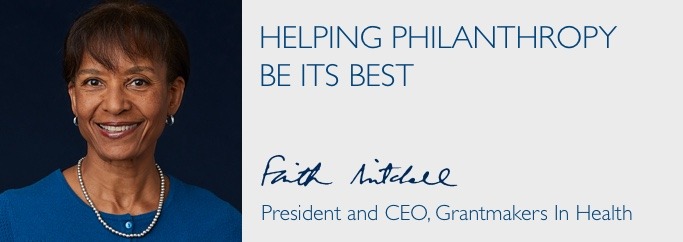
Partnerships are important to GIH. In a panel discussion at SXSW earlier this year, I had an opportunity to make this point and to show how, through partnerships with our fellow philanthropy-serving organizations (PSOs), GIH is able to advance a broader understanding of health—and especially of the social determinants of health—by connecting health funders with their peers from many other sectors. In this issue of the GIH Bulletin, several of our PSO colleagues talk in their own words about the value of partnerships, whether among their funder-members or among PSOs.
We asked our colleagues to reflect on the 2019 GIH annual conference theme of Ideas. Innovations. Impact. The resulting articles pursue a variety of themes, but collectively they make abundantly clear that the central role played by PSOs—making connections among funders in order to stimulate lasting change and improve quality-of-life—continues to be vitally important.
The articles are written by Economic Opportunity Funders; Exponent Philanthropy; Funders Concerned About AIDS; Grantmakers in Aging; Grantmakers in the Arts; Health and Environmental Funders Network; Hispanics in Philanthropy; Neighborhood Funders Group; Philanthropy Northwest; and Sustainable Agriculture and Food Systems Funders. They describe a range of action strategies, including:
- Supporting the coordination and alignment of investments around areas of interest, such as HIV/AIDS, the 2020 census, or to protect people and the environment from toxic chemicals.
- Changing the funder-grantee dynamic to increase the power of communities that do not have equal access to decisionmaking.
- Working across sectors to demonstrate the integral nature of art and culture, health, and community development.
- Developing a long-term strategy to challenge members to get past perceived barriers to engagement with particular communities—in this instance tribal nations, with an eye to increasing the flow of grant dollars to Indian Country.
- Collaborating to collectively change the way Americans think about aging and to build the political will to create a more age-integrated society.
- Leveraging philanthropic resources to strengthen the leadership, influence, and equity of the Latinx population, including improving health outcomes.
- Partnering with other PSOs to help funders understand the environmental and social conditions shaping health and equity outcomes.
- Keeping funders focused on philanthropy’s ultimate mission of bringing about change and transforming communities.
They also describe a range of mechanisms for achieving these goals, including pooled funds; rapid response funds; and learning, leadership, and engagement programming.
But although methods differ, the articles reflect a shared concern for certain results, including strengthening community organizations and stimulating community-based networks; building stronger partnerships and trust between the philanthropic sector and community organizations; and achieving long-term social progress in the form of equity across race, ethnicity, income, and gender.
Just as PSOs strengthen the collective effectiveness of their members, partnerships among PSOs offer valuable opportunities. As Kathy Sessions writes, PSO partnerships may “help philanthropy be at its best, connecting many puzzle pieces into fuller support of people and places through challenging times.” They are a means for us to “aspire to good deeds done well,” in Henry Berman’s words, and to “hold one another accountable” in the process.
Don’t forget to share your comments on Facebook or Twitter!

